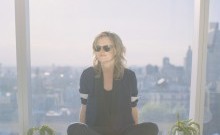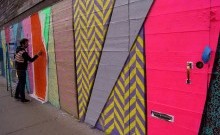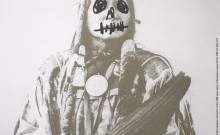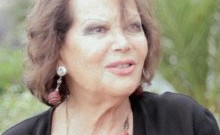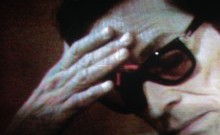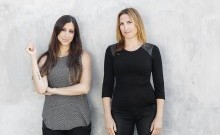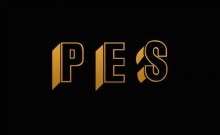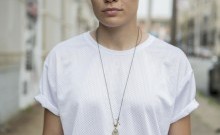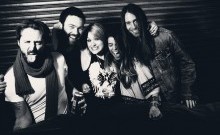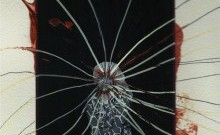Field Scientist
Michael Merck is a field scientist. His studio housed in the Knockdown Center in Maspeth Queens is reminiscent of the careful tending a grandmother takes with her relic case. ReDefining detail through senses we are seriously lacking in today'ss tech obsessed lifestyle. Michael sifts for undiscovered and under looked moments of time, bottling and labeling his findings for further examination. If you've had your hands dirty long enough you'd surely appreciate Mike's view and findings along the path he treads. In the world we take for granted, great men like Mike are here to turn our heads and allow us to look back and notice what we are all missing. His paintings hold tight resolutions of exploration, a mapped plan of attack and victorious celebration narrated in each large canvas. Painted shadows and planes of color depict interior depths comparable to Anselm Kiefer. Compositionally some works bare a table like display as if the viewer were now presented with the opportunity to feast, while other works resemble directional handbooks, symbols seem to respond to questions posed by the artist. Careful and thoughtful attention is paid to the work in a manner that is delicate and genuine. We can all learn from his sensitivity in a city so blinded by hype.
Tom Koehler: Talk about what the Knockdown Center is, how it started, & your path there.
Michael Merck: I met David [Sklar — the current owner of Knockdown Center ] the building when I lived in Austin, Texas. He eventually ended up buying a painting from me. I moved to New York, we stayed in touch, & after a few months, he called me up & said he wanted to show me something. At which point he brought me to what is now known as Knockdown Center, which was a factory that had been in his family for over 50 years, they made doors there. And the factory had recently vacated & moved to New Jersey, & it was pretty wild. It was dark & dirty as he showed me around, & the windows were all cinder blocked up & the back yard was like a jungle. Dusty like the surface of the moon. Seriously, it was the kind of place where when you walked in, you didn't know if you were gonna walk back out of it. The kind of place that bodies are left [in].
TK But he was for real?
MM Yeah, he was for real. And offered me a studio, which was unimaginable --- at the time I was doing really small works, in my studio apt that I shared with another person. He told me just to go & pick out any spot in the building & set up. So I picked this room, which he was really excited by, cause apparently when he was a kid & working in the factory, he always thought that specific room was really cool. And that something amazing could happen in there. And that's how it started. Coming, working on stuff all the time. He'd come back & we'd talk about things & eventually, i think the idea was percolating for some time in his mind, but it seemed like a turning point in terms of how he was thinking about the building. He was trying to sell it, & people were coming to look at it, & they all wanted to demolish it. Put shipping containers in the yard, store stuff from .99 cent stores in the neighborhood. And slowly we just began working out the ideas that laid down the foundation for what Knockdown is now. A lot of that had to do with him feeling like New York wasn't the place he remembered it as, a place where people from all different places ran into each other, & met people, totally different people all the time, & had conversations they weren't expecting. He felt like the social circles in New York were kind of myopic, & just people hanging out with their connections or work-related activities & not getting out of their circles. The potential for the building to be a place where people can just come in, is totally open. Intentionally flexible. A wide open space. To be a prism or conduit for things to come in & go out of. A lot of people show up & they see things they weren't expecting, meet people they weren't expecting, & so on. If you saw it before, you wouldn't believe it. I mean, the nonchalance with which this guy [David] presented this space, that was so worn in from 100 years of industry living here, it was all just kind of like, are you for real? But he was.
TK You guys are investigating a lot of different avenues for the Arts. Some people don't have that kind of space in their life to invest time in so many different aspects of it. By not just being a gallery or showspace it becomes another entity.
MM It's that way by design for a lot of reasons, we want a non-commercial environment for our Arts Space Programming, which we feel New York needs. A lot of people running alternative projects who have figured out outside funding, or maybe they just have investors, people who believe in their vision --- they don't have to move work to stay afloat. There is this division between the risks you can take, & the type of work you present --- & I'm really happy to be a part of this. The space is somewhere between a social space & a creative space. It opens up some freedoms for people, presenting an environment that is unusual & outside of a commercialized version of that.
TK It allows you to take more liberties across the board. What about the curatorial process feeds your own work & the center's sustainability?
MM First & foremost for us, it's the worth of the project, #1. Doesn't matter where it's coming from. Is it interesting? Is it already being looked at? Should it be shared with other people? Ideas really fuel me. Ideas are what push & excite me & get me out of bed every day. The idea of curator is overused & sort of perverted to be ultimately, applied to almost anything, which sort of robs it of its purpose --- which is a way of being or a way of handling objects, caring for objects, & presenting them. One of these things that David & I have been so committed to & is largely cause of his influence, is emphasizing the importance of taking the idea out of the realm of ideas, into the world of actuality. He's pushed me to think about that really hard. That means taking the idea from real, actual things, already [here]. So much of the work we do here is just that --- building a wall, taking down a wall, that is just as important as someone saying I want to do this installation, this is how it works. With the social space vs. the creative space, the ideas of creation vs. the act of making, the lines drawn between art & building, it's all kind of the same thing here. Finding things that are worthy, putting your effort into it, & working hard to make them into exactly what you envision them as.
studio view 2015
"The Illusion of Progress" bronze boots, dimensions variable, 2013-ongoing
"Upside Down Pendulum", oil on canvas, 66 x 72 in., 2012
"Tools," silverware, spray paint, mirror, wood box, 12 x 18 x 3 in., 2014
TK What kind of direction do you see Knockdown going in?
MM Right now, we don't really have a curatorial department. We have a small staff, & our space is as good as the people that get involved. We want to continue to be as open & receptive to what people want to do as we can, to give as many people as possible the opportunity to see the space as an opportunity, & push their work to the next level, any way that we can. If that's a non-profit supporting a cause, or someone working in obscurity getting a chance to present their work, or someone who's been doing good work but never had the space to do a particular project, or teaming a concert with an installation --- it's just a sort of stir the pot philosophy of layering & trying to create unexpected encounters.
TK Where are you from? What places have affected you along the road & shaped you as an artist?
MM I'm from Cedar Rapids, Iowa. I moved all over the place. I don't think I've lived more than 5 years in any one city for any time over the last 19 years. The most influential city I lived in was Chicago, by far. I was there for 5 years. I'm still realizing how important that time was. People from Chicago I'm still continuing projects with, finishing projects with, a lot of them have come here now, & are still reminding me of how vital a scene that was at the time I was there. There were two different kinds of creative activity there --- pretty big galleries, art fairs --- & then people who didn't pay any mind to that, & just made what they thought was pushing art forward. Some of that was just a kind of fearless making within a community, where everyone is pushing, themselves & each other.
TK Both sides were aware of it?
MM I don't know. I didn't know that many on the gallery side. I gravitated to the other side of the fence, which was a really fertile place. Anything goes, that kind of environment. It was extremely productive, & at times extremely destructive. Somehow, in between those, there felt like there was more potential in that reckless experimentation than just trying to see if you could gain access to a social sphere. I found myself identifying with the latter more. Seeking the extremities of making & presenting as opposed to trying to work into a sort of established protocol. I didn't find that interesting, & a lot of people shared my opinion. A lot of work got made, & a lot of things happened. It changed the way I think of & make work. How I think of & approach projects we're presented with here. It's a non-hierarchical idea. Some of the people we present are having fantastic careers, some of them should be having fantastic careers, some don't care either way. Again, is this something I should see? Is this something that is going to open doors, in my own work? Welcoming so many different people here, feels like there's more potential to find & explore experiencing & presenting.
TK Talk about the future.
MM Our space is special & not only physically, but also in the sense of what we want to accomplish. In the sense of recapturing something that may be becoming harder to find in our environment, which is some freedom & some unpredictability. Today we were talking about what we’re going to do. Artists made this city. We made it what it is. In a lot of ways. This is a part of it that really captured the minds of the world. The way artists come to this city, against all odds, except now against all odds means everyone wants to be here, no one can afford to make anything. So what happens to that identity when someone’s not preserving it? David spent his whole life here, & was telling me how he remembers just going out & having a conversation with random people. Now it’s really hard to do that. And I myself have found it difficult to make friends I’m not working with. Everyone’s working hard & it’s like this crazy path we’re on — everyone always has their own objective, everyone’s always in a social space where they’re trying to meet their objective, no one has the space to make what they really want to make — so we want to kind of overturn this path, that the city’s on or maybe already far beyond, & just kind of encourage people to step out of their scene & lure them into unexpectedly encountering things they otherwise wouldn’t — by putting things side by side simultaneously & finding ways to allow people that are making things in a committed way, a way that deserves to be seen — maybe they don’t have a pedigree, it really has nothing to do with anything other than what’s on the page — but finding people & saying Great, you’re on Mars already? or Great, you just crawled out of inner earth? — & figuring out, should we see it?

"Limited Time Only: White Castle Loaded Fries," plaster, 20 x 16 in., 2013
TK It breaks up the routine of it, how we’re capping ourselves. It’s great to see something like Knockdown Center trying to break that.
MM I feel like every other week we pick up everything & move it. The only thing we’re not doing is building permanence. The thing we’re doing is being conduits, being ready to accept anything that could come our way. You can put up a wall, you can take down a wall. Our space is only going to be as good as the space evolves. Just planting the seed of possibility if nothing else is maybe the greatest work we could be doing. All these things you’ve cast aside in your mind, bring them back in.
It’s labor. Actual work that needs to be done. Your work is about this too — the folly of permanence or the idea of permanence. Anyone who creates work that is something of a closed system, something that can take on meaning from multiple angles.
TK What do you believe in?
MM What do I believe? I believe in everything until I doubt.
TK What do you think of the afterlife?
MM I’m enjoying it right now.
TK Favorite type of car?
MM AC Cobra.
TK Picture three objects. What are they?
MM Car, core sample, silverware.
TK How do you feel about space in general?
MM I’m from the midwest.
All images by Joe Roberman, 1985 ©2015.








